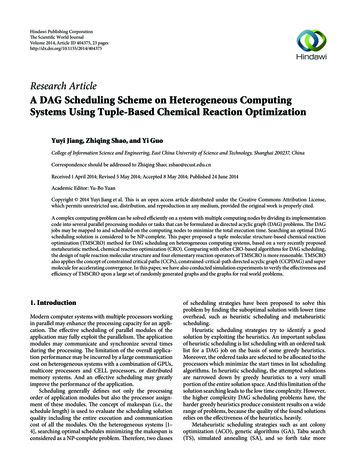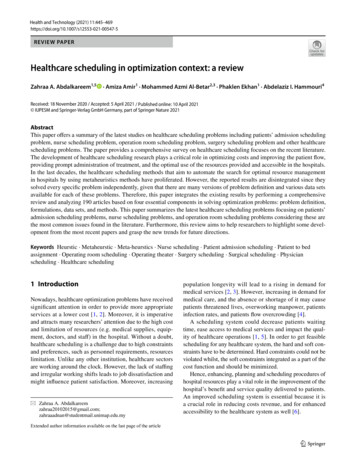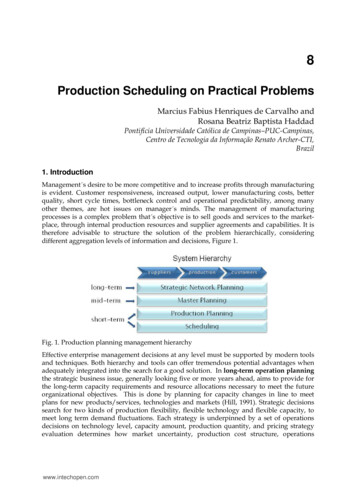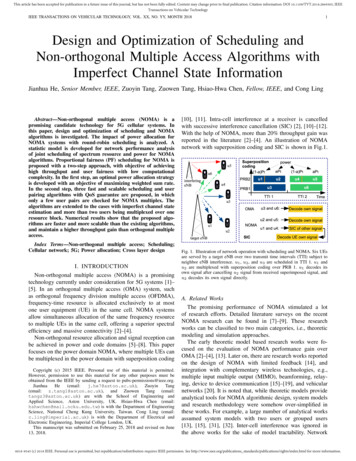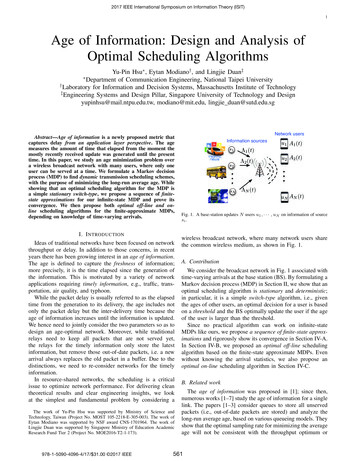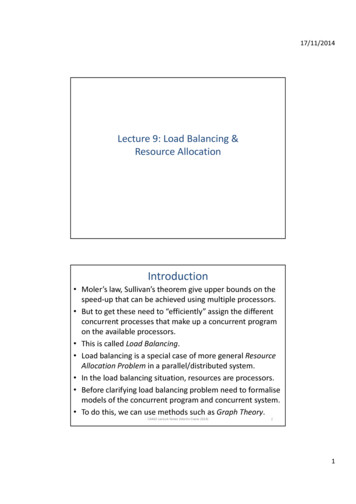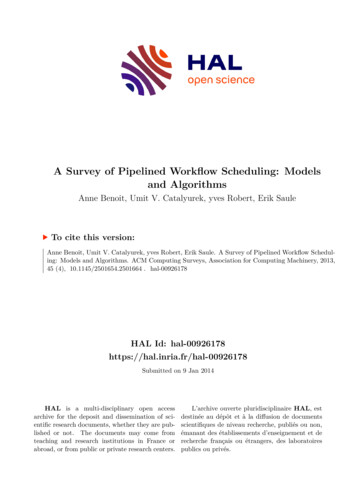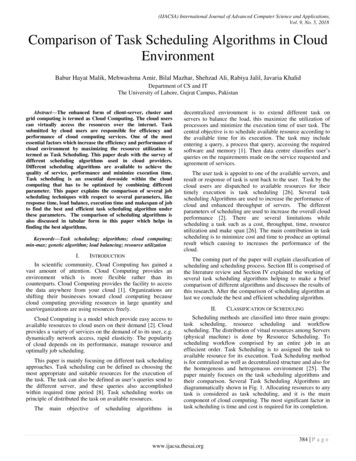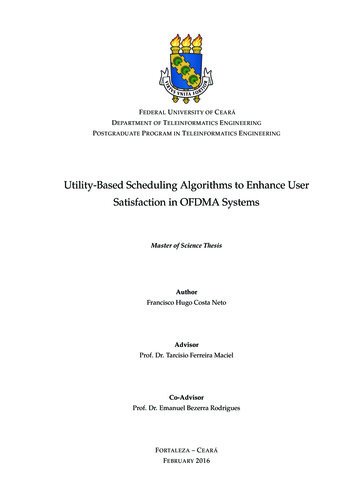
Transcription
F EDERAL U NIVERSITY OF C EARÁD EPARTMENT OF T ELEINFORMATICS E NGINEERINGP OSTGRADUATE P ROGRAM IN T ELEINFORMATICS E NGINEERINGUtility-Based Scheduling Algorithms to Enhance UserSatisfaction in OFDMA SystemsMaster of Science ThesisAuthorFrancisco Hugo Costa NetoAdvisorProf. Dr. Tarcisio Ferreira MacielCo-AdvisorProf. Dr. Emanuel Bezerra RodriguesF ORTALEZA – C EARÁF EBRUARY 2016
U NIVERSIDADE F EDERAL DO C EARÁD EPARTAMENTO DE E NGENHARIA DE T ELEINFORMÁTICAP ROGRAMA DE P ÓS - GRADUAÇÃO EM E NGENHARIA DE T ELEINFORMÁTICAUtility-Based Scheduling Algorithms to Enhance UserSatisfaction in OFDMA SystemsAutorFrancisco Hugo Costa NetoOrientadorProf. Dr. Tarcisio Ferreira MacielCo-orientadorProf. Dr. Emanuel Bezerra RodriguesDissertação apresentada à Coordenação doPrograma de Pós-graduação em Engenharia deTeleinformática da Universidade Federal do Cearácomo parte dos requisitos para obtenção do graude Mestre em Engenharia de Teleinformática.Área de concentração: Sinais e sistemas.F ORTALEZA – C EARÁF EVEREIRO 2016
This page was intentionally left blank
Dados Internacionais de Catalogação na PublicaçãoUniversidade Federal do CearáBiblioteca de Pós-Graduação em Engenharia - BPGEC874uCosta Neto, Francisco Hugo.Utility-based scheduling algorithms to enhance user satisfaction in OFDMA systems / FranciscoHugo Costa Neto. – 2016.84 f. : il. color. , enc. ; 30 cm.Dissertação (mestrado) – Universidade Federal do Ceará, Centro de Tecnologia, Departamento deEngenharia de Teleinformática, Programa de Pós-Graduação em Engenharia de Teleinformática,Fortaleza, 2016.Área de concentração: Sinais e Sistemas.Orientação: Prof. Dr. Tarcisio Ferreira Maciel.Coorientação: Prof. Dr. Emanuel Bezerra Rodrigues.1. Teleinformática. 2. Usuários - Satisfação. 3. Sistemas de comunicação sem fio. 4. Qualidade deserviços. I. Título.CDD 621.38
ContentsAbstractivAcknowledgementsivResumovList of FiguresviList of TablesviiiAcronyms123ixIntroduction11.1Motivation . . . . . . . . . . . . . . . . . . . . . . . . . . . . . . . . . . . . . . . . .11.2State of the Art . . . . . . . . . . . . . . . . . . . . . . . . . . . . . . . . . . . . . . .21.3Thesis Scope . . . . . . . . . . . . . . . . . . . . . . . . . . . . . . . . . . . . . . . .41.4Contributions and Scientific Production . . . . . . . . . . . . . . . . . . . . . . . .41.5Thesis Organization . . . . . . . . . . . . . . . . . . . . . . . . . . . . . . . . . . . .5System Model62.1Key Technologies . . . . . . . . . . . . . . . . . . . . . . . . . . . . . . . . . . . . .62.2Scenario Description . . . . . . . . . . . . . . . . . . . . . . . . . . . . . . . . . . .72.3Performance Metrics . . . . . . . . . . . . . . . . . . . . . . . . . . . . . . . . . . .122.4Comparison Algorithms . . . . . . . . . . . . . . . . . . . . . . . . . . . . . . . . .132.5Simulator Description . . . . . . . . . . . . . . . . . . . . . . . . . . . . . . . . . .14Scheduling Framework to Improve User Satisfaction163.1General Utility-Based Scheduling Framework . . . . . . . . . . . . . . . . . . . . .163.2Maximization of User Satisfaction Using Suitable Utility Functions . . . . . . . .183.2.1TSM/DSM Based on the Logistic Function . . . . . . . . . . . . . . . . . .183.2.2MTSM/MDSM Based on the Shifted Log-Logistic Utility Function . . . .20Performance Evaluation of MTSM Algorithm . . . . . . . . . . . . . . . . . . . . .233.3.1Perfect CSI . . . . . . . . . . . . . . . . . . . . . . . . . . . . . . . . . . . . .233.3.2Imperfect CSI . . . . . . . . . . . . . . . . . . . . . . . . . . . . . . . . . . .30Performance Evaluation of MDSM Algorithm . . . . . . . . . . . . . . . . . . . . .333.4.1Perfect CSI . . . . . . . . . . . . . . . . . . . . . . . . . . . . . . . . . . . . .333.4.2Imperfect CSI . . . . . . . . . . . . . . . . . . . . . . . . . . . . . . . . . . .37Partial Conclusions . . . . . . . . . . . . . . . . . . . . . . . . . . . . . . . . . . . .403.33.43.5
45Scheduling Framework for Adaptive Satisfaction Control414.1Shifted Log-Logistic Utility Function . . . . . . . . . . . . . . . . . . . . . . . . . .414.2Adaptive Throughput-Based Efficiency-Satisfaction Trade-Off Algorithm . . . . .424.3Adaptive Satisfaction Control Algorithm . . . . . . . . . . . . . . . . . . . . . . .444.4Performance Evaluation . . . . . . . . . . . . . . . . . . . . . . . . . . . . . . . . .454.5Partial Conclusions . . . . . . . . . . . . . . . . . . . . . . . . . . . . . . . . . . . .49Conclusions50Appendix A Utility-Based Scheduling with Spatial Multiplexing53A.1 Introduction . . . . . . . . . . . . . . . . . . . . . . . . . . . . . . . . . . . . . . . .53A.2 System Model . . . . . . . . . . . . . . . . . . . . . . . . . . . . . . . . . . . . . . .54A.3 Spatial Multiplexing . . . . . . . . . . . . . . . . . . . . . . . . . . . . . . . . . . .54A.3.1 Orthogonal Random Beamforming . . . . . . . . . . . . . . . . . . . . . . .54A.3.2 Fixed Switching Beamforming . . . . . . . . . . . . . . . . . . . . . . . . .55A.3.3 Joint Scheduling and Beamforming . . . . . . . . . . . . . . . . . . . . . .55A.4 Performance Evaluation of NRT Service Scenario . . . . . . . . . . . . . . . . . . .56A.5 Performance Evaluation of RT Service Scenario . . . . . . . . . . . . . . . . . . . .60A.5.1 ORB Results . . . . . . . . . . . . . . . . . . . . . . . . . . . . . . . . . . . .60A.5.2 FSB Results . . . . . . . . . . . . . . . . . . . . . . . . . . . . . . . . . . . .62A.5.3 Comparison between Orthogonal Random Beamforming (ORB) and FSB62A.6 Conclusion . . . . . . . . . . . . . . . . . . . . . . . . . . . . . . . . . . . . . . . . .63Appendix B Shifted Log-Logistic Function as a Generalization of the Logistic Function 65Bibliography67ii
AcknowledgementsFirst of all, I would like to thank God who has guide me through the good and bad timesof my life.I would like to thank my parents, Ana and Valmir, for their unconditional support. Withoutyour encouragement and assistance I would not have come so far. To my brother, Lui Magno,with whom I could always talk to and laugh. I also thank my beloved Thalita, who alwaysgives to me understanding and encouragement - this work is also your.I am very grateful to my advisor Prof. Dr. Tarcisio F. Maciel and to my co-advisor Prof. Dr.Emanuel Bezerra Rodrigues, for the support, guidance, and valuable suggestions during thesupervision of my studies. I would like to thank Prof. Dr. Fco. Rodrigo P. Cavalcanti for givingme the opportunity to work on the Wireless Telecommunications Research Group (GTEL). It isan honor to be part of this great team.To my friends from GTEL, Mairton Barros, Yuri Victor, Marciel Barros, Diego Sousa, VictorFarias, Laszlon Costa, Darlan Cavalcante, Khaled Ardah, Rafael Vasconcelos, Daniel Araujo,Samuel Valduga, Igor Guerreiro, Carlos Silva, Juan Salustiano, Marcio Caldas and YosbelRodriguez.Thanks to the Innovation Center, Ericsson Telecomunicações S.A., Brazil, underEDB/UFC.40 Technical Cooperation Contract.for the scholarship support.Fortaleza, February 2016.Francisco Hugo Costa Neto.I would like also to acknowledge CAPES
AbstractThe increasing market demand for wireless services and the scarcity of radio resources callsmore than ever for the enhancement of the performance of wireless communication systems.Nowadays, it is mandatory to ensure the provision of better radio services and to improvecoverage and capacity, thereby increasing the number of satisfied subscribers.This thesis deals with scheduling algorithms aiming at the maximization and adaptivecontrol of the satisfaction index in the downlink of an Orthogonal Frequency Division MultipleAccess (OFDMA) network, considering different types of traffic models of Non-Real Time(NRT) and Real Time (RT) services; and more realistic channel conditions, e.g., imperfectChannel State Information (CSI). In order to solve the problem of maximizing the satisfactionwith affordable complexity, a cross layer optimization approach uses the utility theory toformulate the problem as a weighted sum rate maximization.This study is focused on the development of an utility-based framework employing theshifted log-logistic function, which due to its characteristics allows novel scheduling strategiesof Quality of Service (QoS)-based prioritization and channel opportunism, for an equal powerallocationn among frequency resources.Aiming at the maximization of the satisfaction of users of NRT and RT services, twoscheduling algorithms are proposed: Modified Throughput-based Satisfaction Maximization(MTSM) and Modified Delay-based Satisfaction Maximization (MDSM), respectively. Themodification of parameters of the shifted log-logistic utility function enables differentstrategies of distribution of resources. Seeking to track satisfaction levels of users of NRTservices, two adaptive scheduling algorithms are proposed: Adaptive Throughput-basedEfficiency-Satisfaction Trade-Off (ATES) and Adaptive Satisfaction Control (ASC). The ATESalgorithm performs an average satisfaction control by adaptively changing the scale parameter,using a feedback control loop that tracks the overall satisfaction of the users and keep itaround the desired target value, enabling a stable strategy to deal with the trade-off betweensatisfaction and capacity. The ASC algorithm is able to ensure a dynamic variation of the shapeparameter, guaranteeing a strict control of the user satisfaction levels.System level simulations indicate the accomplishment of the objective of developmentof efficient and low complexity scheduling algorithms able to maximize and control thesatisfaction indexes. These strategies can be useful to the network operator who is able todesign and operate the network according to a planned user satisfaction profile.Keywords: Utility Theory, QoS Provision, Satisfaction Maximizationiv
ResumoA crescente demanda de mercado por serviços sem fio e a escassez de recursos de rádioapela mais do que nunca para a melhoria do desempenho dos sistema de comunicação sem fio.Desse modo, é obrigatório garantir o provimento de melhores serviços de rádio e aperfeiçoar acobertura e a capacidade, com isso aumentando o número de consumidores satisfeitos.Esta dissertação lida com algoritmos de escalonamento, buscando a maximização e ocontrole adaptativo do índice de satisfação no enlace direto de uma rede de acesso baseadoem frequência, OFDMA (do inglês Orthogonal Frequency Division Multiple Acess, considerandodiferentes modelos de tráfego para serviços de tempo não real, NRT (do inglês Non-Real Time),e de tempo real, RT (do inglês Real Time); e condições de canal mais realistas, por exemplo, CSIimperfeitas. Com o intuito de resolver o problema de maximização de satisfação com menorcomplexidade, uma abordagem com otimização de múltiplas camadas usa a teoria da utilidadepara formular o problema como uma maximização de soma de taxa ponderada.Este estudo é focado no desenvolvimento de um framework baseado em utilidadeempregando a função log-logística deslocada, que devido às suas características permite novasestratégias de escalonamento de priorização baseada em QoS e oportunismo de canal, parauma alocação de potência igualitária entre os recursos de frequência.Visando a maximização da satisfação de usuários de serviços NRT e RT, dois algoritmosde escalonamento são propostos: MTSM e MDSM, respectivamente. A modificação dosparâmetros da função de utilidade log-logística descolocada permite a implementação dediferentes estratégias de distribuição de recursos.Buscando controlar os níveis de satisfação dos usuários de serviços NRT, dois algoritmosadaptativos de escalonamento são propostos: ATES e ASC. O algoritmo ATES realiza umcontrole da satisfação média pela mudança dinâmica do parâmetro de escala, permitindo umaestratégia estável para lidar com o dilema entre satisfação e capacidade. O algoritmo ASC écapaz de garantir uma variação dinâmica do parâmetro de formato, garantindo um controlerigoroso dos níveis de satisfação dos usuários.Simulações no nível do sistema indicam o cumprimento do objetivo de desenvolvimentode algoritmos de escalonamento eficientes e de baixa complexidade capazes de maximizar econtrolar os índices de satisfação. Estas estratégias podem ser úteis para o operador da rede,que se torna capaz de projetar e operar a rede de acordo com um perfil de satisfação de usuário.Palavras-chave: Teoria da Utilidade, Provimento de QoS, Maximização de Satisfaçãov
List of Figures2.1Curves of link-level used for link adaptation. . . . . . . . . . . . . . . . . . . . . .102.2VoIP Traffic Model [1]. . . . . . . . . . . . . . . . . . . . . . . . . . . . . . . . . . .122.3Simulator flow-chart. . . . . . . . . . . . . . . . . . . . . . . . . . . . . . . . . . . .153.1Utility-based scheduling algorithm flow-chart. . . . . . . . . . . . . . . . . . . . .183.2Original curves of Throughput-based Satisfaction Maximization (TSM) andDelay-based Satisfaction Maximization (DSM) algorithms using the parameteradjustment described by (3.7). . . . . . . . . . . . . . . . . . . . . . . . . . . . . . .3.3Utility functions with scale parameter λ 1 and using different values of shapeparameter. . . . . . . . . . . . . . . . . . . . . . . . . . . . . . . . . . . . . . . . . .3.4Symmetric marginal utility functions, narrower or wider, λ 3dB and λ 3dB,respectively. . . . . . . . . . . . . . . . . . . . . . . . . . . . . . . . . . . . . . . . .3.5. . . . . . . . . . . . . . . . . .2527Performance metrics of the MTSM algorithm compared with the classicalalgorithms Proportional Fair (PF), Rate Maximization (RM) and TSM. . . . . . . .3.923Performance metrics of the MTSM algorithm as a function of the number of NRTusers with different values of shape parameter, θ. . . . . . . . . . . . . . . . . . .3.822Performance metrics of the MTSM algorithm as a function of the number of NRTusers with different values of scale parameter, λ.3.721Shifted log-logistic marginal utility functions with different values of shapeparameter θ. The scale parameter is fixed at λ 0.1088. . . . . . . . . . . . . . . .3.61930Performance metrics of the MTSM algorithm compared with classical algorithmsconsidering imperfect CSI in an urban macro scenario [2]. . . . . . . . . . . . . . .313.10 BLER with imperfect CSI in an urban macro scenario [2]. . . . . . . . . . . . . . .323.11 Performance metrics of the MDSM algorithm as a function of the number of RTusers with different values of scale parameter, λ. . . . . . . . . . . . . . . . . . . .343.12 Performance metrics of the MDSM algorithm as a function of the number of RTusers with different values of shape parameter, θ. . . . . . . . . . . . . . . . . . .363.13 Performance metrics of the MDSM algorithm compared with the algorithmsModified Largest Weighted Delay First (MLWDF), Urgency and Efficiency-basedPacket Scheduling (UEPS) and DSM. . . . . . . . . . . . . . . . . . . . . . . . . . .383.14 Performance metrics of the MDSM algorithm compared with classicalalgorithms considering imperfect CSI in an urban macro scenario [2]. . . . . . . .393.15 BLER with imperfect CSI in an urban macro scenario [2]. . . . . . . . . . . . . . .394.1Adaptive scheduling algorithms flow-chart. . . . . . . . . . . . . . . . . . . . . . .434.2Block diagram representation of (4.3). . . . . . . . . . . . . . . . . . . . . . . . . .43
4.3Behavior of U S-Log and wS-Log with a fixed shape parameter (θ 0) and differentvalues of the scale parameter λ. . . . . . . . . . . . . . . . . . . . . . . . . . . . . .444.4Block diagram representation of 4.4. . . . . . . . . . . . . . . . . . . . . . . . . . .454.5Behavior of U S-Log and wS-Log with a fixed scale parameter and different absolutevalue of the shape parameter, θ 0. . . . . . . . . . . . . . . . . . . . . . . . . . .4.6Performance metrics of the ATES algorithm as a function of the number of NRTusers. . . . . . . . . . . . . . . . . . . . . . . . . . . . . . . . . . . . . . . . . . . . .4.747Performance metrics of the ASC algorithm as a function of the number of NRTusers. . . . . . . . . . . . . . . . . . . . . . . . . . . . . . . . . . . . . . . . . . . . .4.84548Capacity vs Satisfaction plane considering a system load of 10 users - macro cellscenario [3]. . . . . . . . . . . . . . . . . . . . . . . . . . . . . . . . . . . . . . . . .48A.1 Examples of radiation patterns of ORB and FSB beamforming. . . . . . . . . . . .55A.2 Mean throughput per cell of the TSM scheduler with Fixed SwitchedBeamforming (FSB) and Single Input Single Output (SISO) antenna configurations. 57A.3 Satisfaction index of the TSM scheduler with FSB and SISO antenna configurations. 58A.4 Mean Throughput considering different schedulers and FSB with 2 beams. . . . .58A.5 Satisfaction index considering different schedulers and FSB with 2 beams. . . . .59A.6 Evaluation of the DSM technique with Orthogonal Random Beamforming (ORB). 61A.7 Evaluation of different RRA techniques using ORB with 1 beam. . . . . . . . . . .61A.8 Evaluation of the DSM technique with FSB. . . . . . . . . . . . . . . . . . . . . . .62A.9 Evaluation of different RRA techniques using FSB with 2 beams. . . . . . . . . . .63vii
List of Tables2.1SINR Thresholds for Link Adaptation . . . . . . . . . . . . . . . . . . . . . . . . .112.2Parameters of the Voice over IP (VoIP) Traffic Model. . . . . . . . . . . . . . . . .123.1Simulation Parameters of MTSM Evaluation . . . . . . . . . . . . . . . . . . . . .243.2Simulation Parameters . . . . . . . . . . . . . . . . . . . . . . . . . . . . . . . . . .334.1Simulation Parameters of ASC and ATES Evaluation . . . . . . . . . . . . . . . . .46A.1 Simulation Parameters - NRT Service Scenario . . . . . . . . . . . . . . . . . . . .57A.2 Simulation Parameters - RT Service Scenario . . . . . . . . . . . . . . . . . . . . .60
AcronymsThe abbreviations and acronyms used throughout this thesis are listed here. The meaningof each abbreviation or acronym is indicated once, when it first appears in the text.3G3rd Generation3GPP3rd Generation Partnership Project4G4th GenerationATESAdaptive Throughput-based Efficiency-Satisfaction Trade-OffASCAdaptive Satisfaction ControlBLERBLock Error RateBSBase StationCoMPCoordinated Multi-PointCQIChannel Quality IndicatorCSIChannel State InformationDLDownlinkDRADynamic Resource AssignmentDSMDelay-based Satisfaction MaximizationMDSMModified Delay-based Satisfaction MaximizationEDFEarliest Deadline FirsteNBEvolved Node BFIFOFirst In First OutFERFrame Erasure RateFSBFixed Switched BeamformingHOLHead Of LineHSPAHigh Speed Packet AccessLTELong Term EvolutionLTE-ALong Term Evolution (LTE)-AdvancedMACMedium Access ControlMCSModulation and Coding SchemeMIMOMultiple Input Multiple OutputMISOMultiple Input Single OutputMLWDFModified Largest Weighted Delay FirstMTSMModified Throughput-based Satisfaction MaximizationMUMulti-UserNRTNon-Real Timeix
xOFDMAOrthogonal Frequency Division Multiple AccessOFDMOrthogonal Frequency Division MultiplexingORBOrthogonal Random BeamformingOSIOpen Systems InterconnectionPFProportional FairPHYPhysicalQAMQuadrature Amplitude ModulationQoEQuality of ExperienceQoSQuality of ServiceRANRadio Access NetworkRBResource BlockRMRate MaximizationRRARadio Resource AllocationRTReal TimeSINRSignal to Interference-plus-Noise RatioSISOSingle Input Single OutputSNRSignal to Noise RatioSORASatisfaction Oriented Resource AllocationSORA-NRTSatisfaction-Oriented Resource Allocation for Non-Real Time ServicesSUSingle-UserTTITransmission Time IntervalTSMThroughput-based Satisfaction MaximizationMTSMModified Throughput-based Satisfaction MaximizationTUTypical UrbanUEUser EquipmentUEPSUrgency and Efficiency-based Packet SchedulingUMTSUniversal Mobile Telecommunications SystemVoIPVoice over IPWCDMAWideband Code Division Multiple AccessWFQWeighted Fair QueueingZMCSCGZero Mean Circularly Symmetric Complex Gaussian
Chapter1IntroductionThis master’s thesis proposes efficient and low complexity scheduling techniques able toenhance user satisfaction in different scenarios and traffic models. This introductorychapter aims provide an overview of the studies here performed and has the followingorganization: Section 1.1 expounds the motivation and open problems considered to developthis study. Section 1.2 provides a literature review of the main issues addressed. Section 1.3describes the scope of the studies carried out in this thesis. Section 1.4 shows the scientificproduction resulting of the Master’s course. Finally, Section 1.5 describes the organization ofthe remaining of this master’s thesis.1.1 MotivationSince its beginning, the wireless communication networks are characterized by changes inthe amount of exchanged data and the variety of applications that generate this traffic. In 2008,traditional applications like web browsing, email and file sharing accounted for a preponderantpercentual of the total traffic in the Internet. In 2013, Voice over IP (VoIP) and video streamingwere responsible for almost half of the total traffic [4].Mobile data traffic grows continuously, according to [5] the period between 2010 and2015 is portrayed by a continued and strong increase of 14% quarter-on-quarter and 65%year-on-year. The growth in data traffic is carried both by increased smartphone subscriptionsand a continued improvement in average data volume per subscription, fueled by videostreaming.It is expected that this behavior will be maintained over the next decade, with a tenfoldincrease of global mobile data traffic between 2014 and 2019 [6]. In the end of 2014, the numberof mobile-connected devices exceeded the number of people on earth, and by 2019 there willbe nearly 1.5 mobile devices per capita.Therefore, the increasing market demand for wireless services and the scarcity ofradio resources calls more than ever for the enhancement of the performance of wirelesscommunication systems. Nowadays, it is mandatory to ensure the provision of better radioservices and to improve coverage and capacity, thereby increasing the number of satisfiedsubscribers [7].
21.2. State of the Art1.2 State of the ArtThe scheduling algorithms are responsible for resource allocation among users and impactdirectly the bandwidth usage efficiency. Many scheduling algorithms have been proposed inthe last decade, spanning from the high cell capacity to fairness and the satisfaction of Qualityof Service (QoS) requirements [8].The most common schedulers operate regardless of channel conditions, e.g.: i) First InFirst Out (FIFO), that serves users according to the order of service requests; ii) round robin,algorithm that schedules users in a circular manner; iii) Earliest Deadline First (EDF), whichschedules the packet that will be expired the soonest; iv) Weighted Fair Queueing (WFQ), thatassigns resources considering the weights associated with every user. The channel unawareschedulers were first introduced in wired networks, they are very simple, but sometimes canbe very inefficient and unfair [7, 8].Scheduling algorithms that consider Physical (PHY) layer information, like the channelstate, are able to exploit more efficiently the resources of the system.The concept ofopportunistic scheduling, i.e., consider the channel quality variations and improve the systemcapacity was first employed in [9], that proposed a power control scheme in which the users areallocated more power when their channels are good, and less when they are bad. This strategyis known in the literature as Maximum Rate [7] or Maximum Throughput [8].The maximum rate strategy is able to maximize cell throughput, but results in an unfairresource sharing since users with worst channel conditions only get a low percentage of theavailable resources, in the extreme case they may suffer starvation. Proportional fair schedulinghas received much research attention due to its capability on the trade-off between spectralefficiency and fairness [10, 11]. The authors of [12] provide anlytical expressions to evaluatethe performance of random access wireless network in terms of user throughput and networkthroughput subject to a proportional fairness algorithm scheduling resources between usersand show the ability of the algorithm to schedule resources avoiding unfairness among users.Other study evaluates a scheduling algorithm which maintains the fairness level in scenarioswith fluctuating load. Moreover, shown that the cell throughput can be improved [13].Maximum throughput and proportional fairness are examples of scheduling algorithmsthat consider the channel condition.However, channel awareness does not imply QoSprovisioning, essential feature to applications such as as video streaming and VoIP. There areseveral QoS objectives, e.g., throughput, delay, jitter, and latency. Among these QoS metrics,received the most attention delay [14, 15] and throughput [16, 17].In this work, the problem of scheduling using an utility-based algorithm is investigated.Initially proposed to be used in communications network problems in [18], utility theoryquantifies the resources’ usage benefits or evaluates the degree to which a network satisfiesservice requirements of users’ applications.The research carried out in [19] investigated the properties of the optimal sub-carrierallocation associated with utility-based optimization and demonstrated that its resourceallocation balances spectral efficiency and fairness. Based on that theoretical framework, thesame authors proposed frequency assignment algorithms in order to maximize the average
1.2. State of the Art3utility in Orthogonal Frequency Division Multiple Access (OFDMA) wireless networks [20].Their results indicated that the utility-based cross-layer optimization could enhance the systemperformance and guarantee a fair resource allocation. The studies performed in [21] alsoconsidered a network utility maximization in OFDMA systems to assure a fair and efficientresource allocation. The problem was decomposed into rate control and scheduling problemsat the transport and medium access control layers, respectively.The topic of satisfaction maximization for Non-Real Time (NRT) services was object ofstudy of [22–24]. The works [22] and [23] proposed and evaluated a heuristic downlinkscheduling algorithm called Satisfaction Oriented Resource Allocation (SORA) whose mainobjective is ensure the achievement of a minimum QoS requirement in order to maximize thenumber of satisfied users. The authors of [24] developed an adaptive scheduling framework.The authors of [25] proposed a downlink scheduling algorithm initially designed for VoIPservice, which aims maximize the number of satisfied Real Time (RT) users in the system.The authors of [26] proposed utility-based algorithms, called Throughput-basedSatisfaction Maximization (TSM) and Delay-based Satisfaction Maximization (DSM) whichprovided a QoS-aware scheduling that maximizes the satisfaction of NRT and RT users,respectively.The study performed in [27] combined TSM with Fixed Switched Beamforming (FSB) toexploit spatial and multi-user diversity. In [28], DSM is combined with FSB and OrthogonalRandom Beamforming (ORB) to evaluate the effect of spatial diversity with this utility-basedscheduling algorithm in a scenario with RT services.Beamforming techniques such as ORB and FSB attracted significant interest becausethey demand only a very small amount of Channel State Information (CSI) (i.e., ChannelQuality Indicators (CQIs)) to be fed back to the Evolved Node B (eNB), mostly Signal toInterference-plus-Noise Ratio (SINR)-related measurements for each candidate beam at theeNB. Since CQIs are simply scalar values, the signaling demand is relatively low. Measurementand signaling can also be kept almost transparent to the users if the eNB carefully coordinatesthe processing of acquiring CQIs from their served users. Since only a few beams are expectedto be active at each period, the user could also report CQIs corresponding only to their bestbeams. Moreover, these strategies can improve system performance by exploiting multiuserdiversity and spatial multiplexing gains, offering feasible coverage and capacity extensionwithout a massive feedback load [29].According to the beamforming technique, a set of precoding vectors (beamformers) will begenerated at the eNB, which will schedule users based on their achievable rates (representingusers’ CQI) and on utility-based weights [30]. Thus, it will be possible to investigate capacity,fairness and QoS trade-offs of the combination of the scheduling and beamforming techniques.Whereas the optimum beam selection algorithm needs an exhaustive search over the entire setof beams and users, the beamforming schemes present low computational complexity by usingsuboptimal beam selection procedures [31].In [32], the TSM algorithm is evaluated considering imperfections of CSI and interference.The scheduling algorithms ought to ensure that users achieve their QoS requirements,
1.3. Thesis Scope4regardless their channel conditions. Other studies in the literature have already addressedthe issue of resource allocation assuming perfect CSI at the transmitter [21, 33]. However,the perfect CSI assumption (without estimation errors nor channel feedback delay) cansignificantly deteriorate the system performance [34,35]. Unsuccessful transmissions can occurwhen the BS assigns a certain rate to a user based on a nominal CSI that cannot be supportedby the true channel state [36].It was demonstrated in [37] that the introduction of a noise term in the CSI estimationyields significant performance degradation. The statistical description of the CSI uncertaintycan be exploited aiming at maximizing the system capacity, as illustrated in [36]. Besides thethroughput metric, fairness can also be considered on resource allocation schemes taking intoaccount imperfect CSI, which has already been investigated in [38].1.3 Thesis ScopeIn this study we consider the problem of improving and controlling the percentage ofsatisfied users i
of efficient and low complexity scheduling algorithms able to maximize and control the satisfaction indexes. These strategies can be useful to the network operator who is able to design and operate the network according to a planned user satisfaction profile. Keywords: Utility Theory,QoSProvision, Satisfaction Maximization iv
